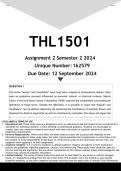THL1501
Assignment 2 Semester 2 2024
Unique Number: 162579
Due Date: 12 September 2024
QUESTION 1
The terms "beauty" and "aesthetics" have long been subjects of philosophical debate, often
seen as subjective concepts influenced by personal, cultural, or historical contexts. Marcia
Eaton, in her book Basic Issues in Aesthetics (1998), explores the complexities surrounding the
definitions of these terms. Despite the difficulties, it is possible to argue that "beauty" and
"aesthetics" can be defined objectively. By examining the foundations of aesthetic theory and
drawing from Eaton’s arguments as well as contemporary examples, this essay will argue that
these concepts, while nuanced, can be understood through universal principles that transcend
DISCLAIMER & TERMS OF USE
1. Educational Aid: These study notes are designed to serve as educational aids and should not be considered as a
substitute for individual research, critical thinking, or professional guidance. Students are encouraged to
conduct their own extensive research and consult with their instructors or academic advisors for specific
assignment requirements.
2. Personal Responsibility: While every effort has been made to ensure the accuracy and reliability of the
information provided in these study notes, the seller cannot guarantee the completeness or correctness of all
the content. It is the responsibility of the buyer to verify the accuracy of the information and use their own
judgment when applying it to their assignments.
3. Academic Integrity: It is crucial for students to uphold academic integrity and adhere to their institution's
policies and guidelines regarding plagiarism, citation, and referencing. These study notes should be used as a
tool for learning and inspiration, but any direct reproduction of the content without proper acknowledgment and
citation may constitute academic misconduct.
4. Limited Liability: The seller of these study notes shall not be held liable for any direct or indirect damages,
losses, or consequences arising from the use of the notes. This includes, but is not limited to, poor grades,
academic penalties, or any other negative outcomes resulting from the application or misuse of the information
prov
]
, For additional support +27 81 278 3372
QUESTION 1
Introduction
The terms "beauty" and "aesthetics" have long been subjects of philosophical debate, often
seen as subjective concepts influenced by personal, cultural, or historical contexts. Marcia
Eaton, in her book Basic Issues in Aesthetics (1998), explores the complexities surrounding
the definitions of these terms. Despite the difficulties, it is possible to argue that "beauty"
and "aesthetics" can be defined objectively. By examining the foundations of aesthetic
theory and drawing from Eaton’s arguments as well as contemporary examples, this essay
will argue that these concepts, while nuanced, can be understood through universal
principles that transcend individual preferences.
Defining Aesthetics and Beauty
To understand whether "beauty" and "aesthetics" can be defined objectively, it is essential
to first explore their meanings. Aesthetics, as a branch of philosophy, examines the nature
of art, beauty, and taste. It is concerned with the creation and appreciation of beauty, as well
as how individuals perceive and interpret sensory experiences. Beauty, on the other hand,
refers to qualities that give pleasure to the senses, particularly sight, and is often associated
with harmony, symmetry, and balance.
Eaton acknowledges that beauty is often viewed as subjective because what one person
finds beautiful may not appeal to another. However, she argues that there are objective
features of objects that make them aesthetically pleasing, and these features can be
universally recognized. For instance, the proportion and symmetry of classical architecture
or the harmony in musical compositions are often seen as beautiful across different cultures
and time periods. Such qualities can be measured and appreciated based on aesthetic
principles, suggesting that beauty is not entirely in the eye of the beholder.
Objective Features in Aesthetics
One of the key arguments for the possibility of defining aesthetics and beauty objectively
lies in the existence of measurable, universal principles. In her discussion, Eaton points to
the idea that certain patterns, proportions, and balances are consistently recognized as
aesthetically pleasing. For example, the "golden ratio," a mathematical proportion found in
nature, art, and architecture, is often cited as a basis for objective beauty. The Parthenon in
Athens and Leonardo da Vinci's Vitruvian Man are often held up as examples of the golden




